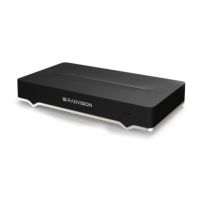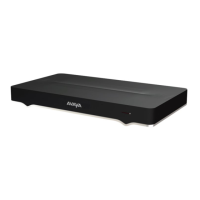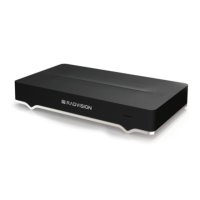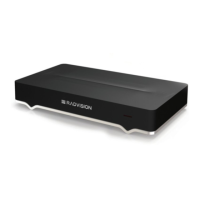Table 27: Configuring the IP address
Field Name Description
IP Address Mode or
Automatic IP Address
Determines if the IP address is dynamically allocated (using DHCP), or if
you manually designate a static IP address. You must use only static
addresses for:
• Scopia
®
XT Telepresence deployments
• Units on a public network
• SIP deployments where the unit is secured with a TLS certificate.
IP address Enter the system static IP address. For dynamic IP addresses, this field
displays the current IP address.
Subnet mask Enter the subnet mask associated with the IP address. For dynamic IP
addresses, this field displays the current subnet mask.
Gateway (IP Address) Enter the default gateway static IP address. The gateway is used to route
information between two subnets, for example, between the headquarters
and a partner site. For dynamic IP addresses, this field displays the
current gateway IP address.
DNS (Server IP
Address)
Enter the DNS server IP address. The DNS server translates domain
names into IP addresses. For dynamic IP addresses, this field displays
the assigned DNS server IP address.
6. From the web interface only, select Save.
Related Links
Configuring Advanced Network Settings on page 116
Configuring Advanced Network Connectivity
About this task
This section describes how to determine which of the two network ports is the first choice to
communicate on a call, and to configure advanced properties of the network connections in each
network port, including the network speed and packet size (MTU). To avoid connectivity issues,
match these settings to the equivalent settings in the network.
In addition, if your large network is split into virtual sub-networks to limit the range of broadcasts,
known as VLANs, and your network components support 802.1q compliant VLAN tagging, you can
assign a VLAN ID to tag the XT Series as belonging to a specific VLAN.
You can also configure network security authentication to be 802.1x compliant, where it sends a
username and password to your 802.1x authenticator, which verifies the login with the
authentication server.
In some XT Series models, activating the second network port GLAN2
(dual-NIC) requires an
additional license (see Activating the XT Series and its Optional Features on page 78). Both small
businesses and large enterprises may require both network ports (see
Connecting Avaya Scopia
®
XT Series to the Network on page 46).
Advanced Configuration of the XT Series
118 Avaya Scopia
®
XT Series Deployment Guide April 2015
Comments? infodev@avaya.com

